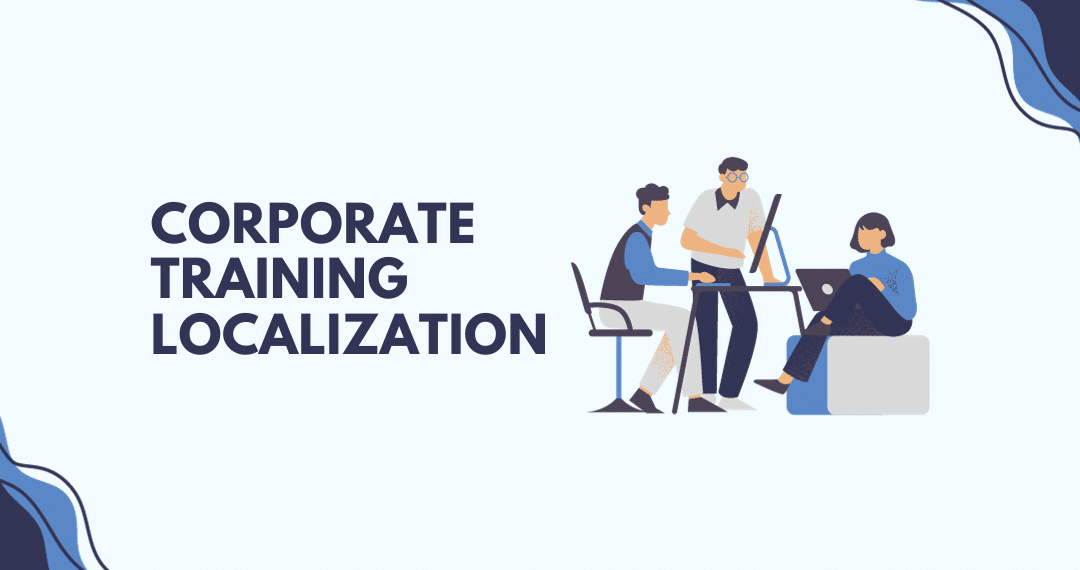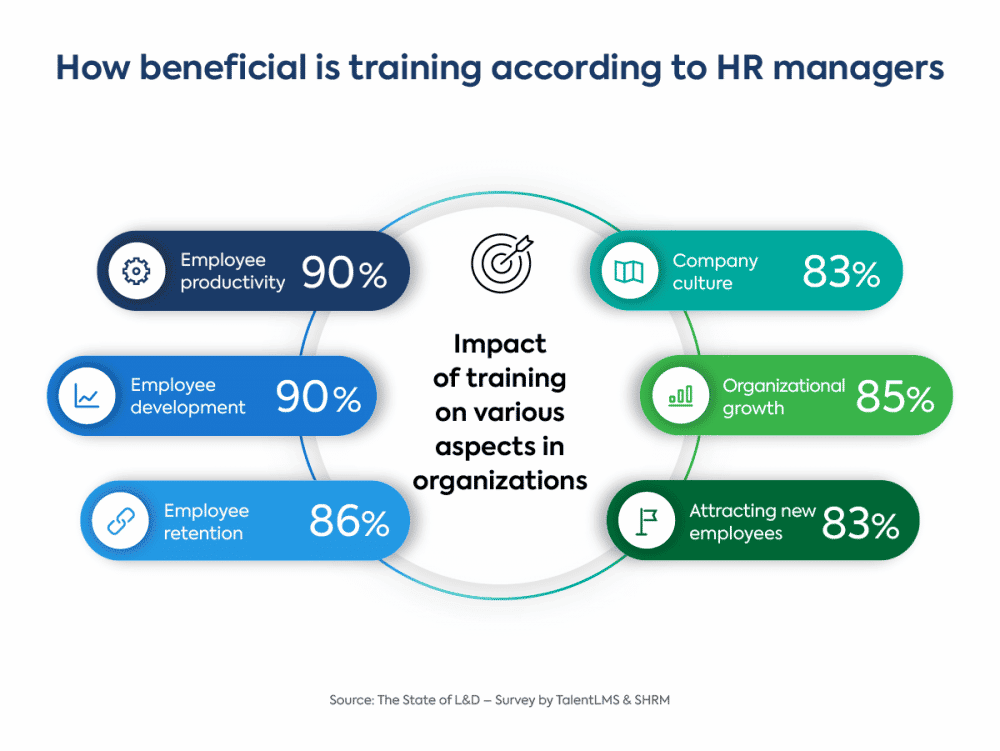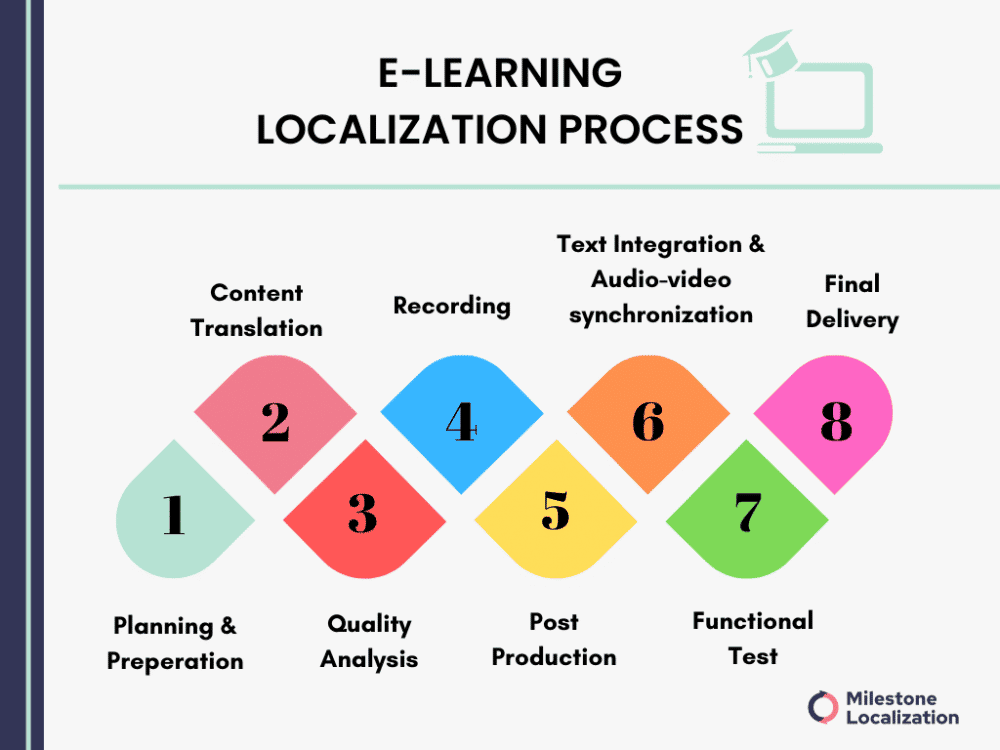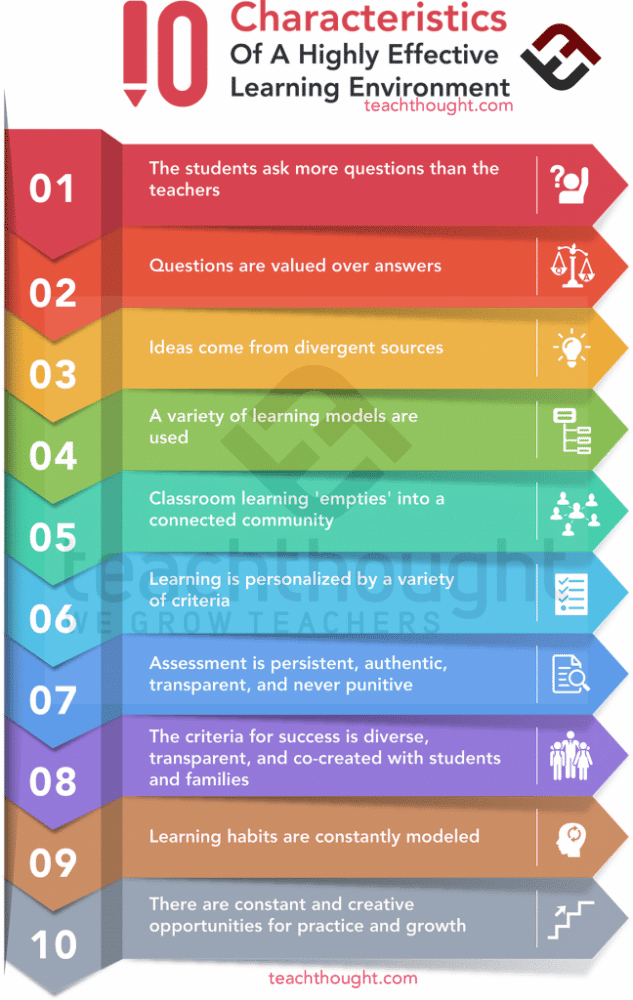Globalization made it possible for companies to grow beyond the borders of their home countries. Global companies today have access to a diverse cross-selection of talent around the world.
Of course, with the right employees, every company can achieve growth. In this regard, training is an essential tool in fulfilling the potential of your talented employees.
If you are a global company, and you want your international trainees to thrive in an engaging learning environment, you should invest in corporate training localization.
Localization provides you with the opportunity to adapt your materials to the specific needs of your employees. In other words, your materials will not only be translated into their native language but will also be culturally appropriated specifically for their beliefs.
In this way, you will make them feel cared for and appreciated while improving their engagement and retention.
In the following blog, you will learn everything you need to know about the importance of corporate training and how to localize your materials properly to achieve the best results.
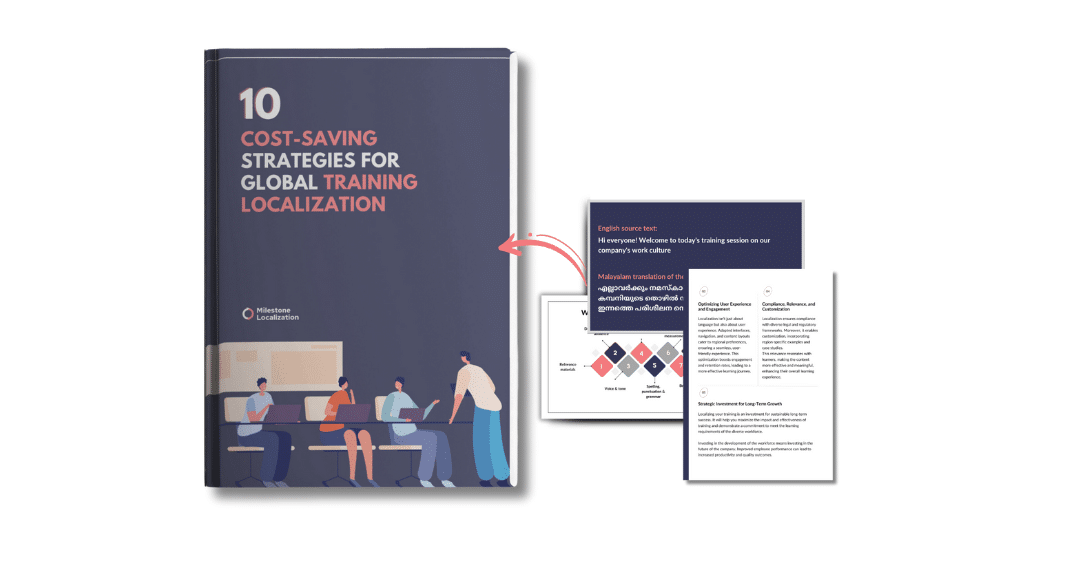
DOWNLOAD OUR FREE EBOOK - 10 COST SAVING STRATEGIES FOR GLOBAL TRAINING LOCALIZATION
Why is it so important to train your employees?
Training is crucial to your company’s success. According to statistics, 94% of employees state that they are more likely to stay at a company longer if their employers actively provide them with learning opportunities and training.
In addition, 68% of workers regard development opportunities and training as the most crucial policy of any organization. In this regard, 87% of millennials view training and learning opportunities at the workplace as very important.
And while employees seem to be more than happy to learn, companies can also reap the benefits. Indeed, companies that invest in corporate training have a nearly 25% higher profit margin. The consequences of lack of training are clear as well: on average, ineffective training costs companies over $13 million per 1000 employees every year.
As you can see from these statistics, investing in your workforce’s knowledge and skills is investing in the growth and success of your company. Through corporate training, you can enhance your staff’s skills and experiences. Knowledgeable employees, in turn, are a great asset to drive your company’s growth forward.
What’s more, corporate training helps you educate your staff on the future leadership needs and goals of your company. This way, all your employees will be working towards the same goal, making you a competitive player in the global market.
However, providing your staff with some training material won’t be enough to reap the benefits of corporate training. You need to create the perfect environment for your workforce and ensure that they will enjoy every minute of the learning process.
Localizing your corporate training materials can be the best way to do so. Through localization, you can prepare all the resources in an adapted form that is easy to comprehend and remember.
What is localization?
Localization is a process whereby content or a specific product is adapted to a target locale or market.
While translation is a crucial part of this process, localization goes beyond language. It takes into consideration the local cultural norms and beliefs, as well as local laws and other requirements and standards.
As a whole, localization considers several different aspects, such as:
- Written content
- Visual content (e.g., images, graphs, emojis, corporate colors, etc.)
- Audio and video content (e.g., subtitling and voice-over)
- Formats (e.g., dates, currencies, units of measurement, addresses, phone numbers, etc.)
- User Experience elements (e.g., buttons, menu items, layout)
Translation companies provide professional localization services and partnering with the right translation agency can make the process easier.
Also read: Localization vs Globalization vs Internationalization vs Translation
What is corporate training localization?
When it comes to corporate training localization, one should take into consideration what types of materials should be adapted, such as:
- e-learning Videos
- PowerPoint Presentation slides
- Training Manuals
- Instructor Guides
- Promotional Advertorials
- Quick Reference or Job Aids, etc.
Corporate training localization takes into consideration every aspect of your training materials. This means that as a first step, all the textual content is translated into the target language. Then, all graphs and colors are adapted to the target culture.
Depending on the script of the target language, certain changes in the fonts or the layout of the materials might be necessary. A necessary aspect of corporate training localization is the adaptation of formats when it comes to dates, currencies, units of measure, phone numbers, currencies, etc.).
In addition, if your training materials include video, a subtitle, or/ and voice-overs in the target language are added.
What you should strive for with corporate training localization is content that looks authentic. So, your localized training materials should look as if they are specifically created for their target audience.
Also read: Everything About Multilingual Subtitles for E-Learning Videos
Importance of corporate training localization
Digitalization and Globalization have made it possible for global companies to operate in several geographical locations simultaneously.
To obtain the same standards and expertise, all new employees, regardless of their location, should undergo corporate training for new employees.
However, providing the same training content to your global workforce won’t get you the expected results.
In fact, if you want to make the learning process much more effective, you should localize your training materials. Providing adapted materials will generate much better retention and engagement with the training. In this way, your employees will feel much more involved and devoted to the learning process.
Indeed, there are many more benefits of corporate training localization. If you want to learn more, keep reading.
The top five benefits of localizing your corporate training
Localization is a complex process that brings many benefits. When it comes to corporate training, localized and adapted materials can allow your trainees to feel relaxed and motivated while learning.
Here are the top five benefits of localizing your content.
Boost engagement and retention
Undoubtedly, the biggest benefit of localizing your training materials is, indeed, enhancing engagement.
If your content does not resonate with your workforce, they are unlikely to feel motivated and involved in not only learning but contributing to the overall training process. Content that does not reflect the cultural views of your employees might be confusing and even offensive to them.
By adapting your training materials to the linguistic and cultural background of your employees, you will bring them closer to the discussed topics.
What’s more, providing the information in their native language will definitely boost their retention abilities. So, eventually, your workforce will be able to learn faster and more efficiently while also being genuinely interested in the training materials.
Hence, localization can help you achieve your performance goals much more effectively.
Also read: eLearning Translation: How to Make Learning International
Promote diversity and inclusivity in the workspace
Besides providing your workforce with the perfect environment to increase their engagement, you have to show your employees that you value them. Localized materials, adapted specifically for their needs, are the best way to show your staff that you care for their cultural backgrounds and respect their beliefs.
In this way, localization helps you actively promote diversity and inclusivity by welcoming people from different cultural and linguistic backgrounds.
Keep in mind that the content you offer should not only be informative but should be created with their social and cultural background in mind.
Consider the cultural aspect
In today’s globalized world, many employers underestimate the importance of the local culture. Some people tend to assume that we are all the same, regardless of our environment.
Needless to say, this is wrong.
The cultural aspect of our environment has a huge influence on our way of thinking and behaving. Thus, global companies should take into consideration the cultural and social systems of their employees, especially when devising their training materials.
For instance, in Thailand, the color purple is associated with death and mourning, so you should avoid it at all costs in your materials for your Thai employees.
By using culturally appropriate symbols, images, and colors, you can create a program that really resonates and connects the learners.
Also read: Localizing Colors for Different Cultures
Maintain accuracy and standardization
Localization is not all about culture. Indeed, this service can help you standardize your content and make it more accurate to the target locale.
For instance, if you have a guide regarding body language during meetings, you should pay close attention to the messages it delivers. Your Japanese or Chinese employees might be confused by a picture of two people shaking hands since they are accustomed to greeting each other by bowing.
To avoid similar misunderstandings, you can adapt your guides and your overall content to each of your target locales. In this way, the information will be accurate to the given locale.
Overall, corporate training localization can help you make your content more accurate while standardizing the practices of your organization.
Comply with the local legal requirements
In some countries, it is mandatory to provide your workforce with training materials in their local language along with English. In this regard, corporate training localization can help you not only comply with the local legal requirements but also conduct your training smoothly and more effectively.
Also read: Top Qualities of a Good Translation
Looking for a reliable translation partner to localize your corporate training materials?
Our expert linguists and specialists can translate your employee training materials into 70+ languages, accurately capturing all cultural nuances.
Challenges in localizing corporate training
Of course, localization has its challenges. It is a complex process operated by huge localization teams, so stumbling rocks are inevitable. However, becoming aware of them is the best way to avoid them.
Focus on the target audience and their language variety
The language you want your training materials translated and localized in is not enough to provide the quality training you want. Indeed, the locale of your employees is crucial when it comes to localization.
For instance, if a client requests to have their corporate training content localized in Spanish, this might lead to re-work and additional costs eventually.
Why?
Because the Spanish spoken in Spain, Mexico, Columbia, Argentina, etc., is not the same language. Thus, clients need to be very specific about their target audience and their exact location, to determine the language and its appropriate variety.
There are different varieties of the Spanish language in various locales, and sometimes differences could result in very little mutual intelligibility between them.
Also read: Spanish Localization: Should You Localize into LA or European Spanish
Thus, it is of prime importance to consider not only the language but also the locale of your employees when you plan on localizing your content.
Strive to enhance engagement and retention
The end goal of your training materials is to educate your employees. To maximize the results, you need to look for ways to enhance retention and engagement while avoiding confusion at all costs.
Avoid offensive content: Adapt your content to the culture of your target audience. This means that you should not include any offensive images or symbols in your materials.
For example, a picture of a man wielding a gun for your New Zealand audience might be appalling to them and thus, they might feel offended by your content.
Avoid unprofessional presentations:As a global company, you need to live up to certain expectations. One of these is related to presentations. If your slides are not synced with the voice-over, the layout is messy, spelling mistakes or whole words are missing, your employees’ interest is likely to decrease.
What’s more, they might even be disappointed that their company hasn’t put in the best effort when it comes to their training.
Avoid using an inappropriate tone of voice: Regardless if you opt for subtitles or voice-overs, you should pay close attention to the tone of voice in your learning materials.
This, again, is a cultural aspect that you need to consider. In some cultures, there are informal and formal forms for referring to people. So, depending on your employees’ age, social status, and cultural background, you should opt for the most suitable option.
Otherwise, you risk making them feel underappreciated and even offended by the lack of respect.
Also read: Top Translation Companies in the UK: How to Choose The Best One

DOWNLOAD OUR FREE EBOOK - 10 COST SAVING STRATEGIES FOR GLOBAL TRAINING LOCALIZATION
Best practices for localizing your corporate training
Localization can be much more effective when you have some insider tips. So, here is a list of some best practices that you can try to speed up the localization process.
Proofreading your content
One of the best ways to provide high-quality, error-free training content is proofreading. Even the tiniest spelling or punctuation errors can have a detrimental effect on your employees’ concentration.
Thus, it is wise to invest in proofreading services. In this way, you can ensure that your content can be understood by your employees and won’t cause any confusion.
Also read: Machine Translation and Post Editing: Everything You Need to Know
Use various types of content
One of the tasks of localization is to adapt and modify the content to the needs of the target audience. The end goal is to provide localized content that appears as if created specifically for the target audience.
Of course, regardless of their form, the materials should not lose their original meaning. Indeed, the message should remain the same regardless of the form under which it is transmitted to the learners.
High-quality visual materials
As a global company, you have a reputation, and you should reinforce it in every possible way. Providing quality presentations and training materials is a good way to show your employees how much you value them.
Hence, it is a must to use only high-resolution graphs and images which can showcase the intended message to the target audience.
When it comes to corporate training localization, you need to make sure that all elements of the graphic content are adapted. This includes their color scheme and any text that is featured, as well as symbols and signs.
Create an appropriate learning environment
The right layout and color scheme of your content can enhance your trainees’ interest and learning abilities. Thus, you should ensure that even the tiniest details of your training materials’ design are appropriate for the target audience.
Look closely at colors, fronts, spaces, text sizes, and graphics, and make sure that they suit the purpose of your content and are appropriate for your audience.
This point is especially important for languages that use characters, such as Japanese and Chinese. Characters tend to take up less space, so you need to make sure that your PowerPoint slides look balanced with text and images.
Keep it relevant and simple
Training can take weeks and months to accomplish, so you need to make sure that you will keep your trainees’ interest and attention during the whole time. Presenting your audience with relevant narratives, including real-world, culturally-specific examples, can be very helpful in this regard.
What’s more, keep your content as simple as possible. Don’t use long, hard-to-comprehend sentences. Instead, focus on transmitting all the information in a simple language. This will make the translation and localization process much easier as well.
Adapt the GUI beforehand
The graphical user interface (GUI) often needs to be customized during localization because of text expansion. This is a costly and time-consuming alternative, so you should try to avoid it at all costs.
Also read: Reduce Localization Costs: 6 Tried and Tested Ways
When you start assembling and designing your course materials, ensure there is enough space for text expansion.
Choosing the right localization partner
If you devise your localization strategy correctly, it can open many doors for your company. However, when you skip localization altogether or execute it poorly, you risk disappointing and even offending your trainees.
To achieve the best results and fulfill your company’s full potential, always rely on professional services. Especially for localization, Google Translate is a no-go.
Also read: Pros & Cons of Using Google Translate for Business
Localization is a complex process that goes beyond language and requires the services of several different experts such as linguists, web developers, graphic designers, software engineers, etc.
Professional translation and localization agencies work with localization teams that not only have the required expertise and working experience but are also equipped with the right technologies, which can make the whole process much faster and easier.
Also read: 7 Reasons to Work With a Translation Company on Your Next Project
Conclusion
Localizing your corporate training content is an investment in your company’s growth. Providing materials adapted to the cultural and linguistic background will help them engage better with the information. On the other hand, corporate training localization is a great way to show your staff that you value their diversity and respect their beliefs.
Still, localization can be a challenging process, so making use of some well-tested best practices is advisable. What’s more, finding a reliable localization partner with the right expertise and professional experience will help you achieve the best results.
Indeed, localized training materials can help you fulfill the maximum potential of your talented employees while making them feel appreciated. This way, your staff will be happy to work and learn at your company.
Do you want to get your corporate training localized by a reliable translatio partner?
Our expert linguists and specialists can translate your employee training materials into 70+ languages, accurately capturing all cultural nuances.

